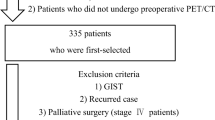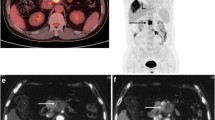Abstract
Purpose
The aim of the study was to determine the accuracy of [18F]fluorodeoxyglucose (FDG) PET/CT in the search for the primary and the presence of a malignancy. The prognostic value of FDG-PET/CT information was tested.
Methods
A total of 190 patients were retrospectively analysed: 82 with histologically proven metastases (HPM) and 108 with clinical suspicion of the presence of a malignancy (CSM). The sensitivity and specificity were determined. Overall survival was calculated to evaluate the prognostic value of the FDG-PET/CT findings.
Results
In the search for the primary, the sensitivity and specificity were 62.0% and 81.9%, respectively. In the search for the presence of a malignancy, the sensitivity and specificity were 93.6% and 85.7%, respectively. Between the HPM and CSM groups, no significant difference in sensitivity and specificity was found either in the search for the primary or in the search for the presence of a malignancy. No significant difference in the sensitivity and specificity was found between 78 patients who were investigated by contrast-enhanced FDG-PET/CT and the remaining patients. A significantly shorter overall survival was found among patients with positive FDG-PET/CT findings compared with patients with negative findings (p = 0.00001); no significant difference in survival was found between the HPM and the CSM group (p = 0.770).
Conclusion
FDG-PET/CT imaging is very helpful in the search for the presence of a malignancy in patients with carcinoma of unknown primary syndrome. FDG-PET/CT is less accurate in identifying exactly the site of a primary. Discovery of a hypermetabolic lesion was associated with the worst survival rate.



Similar content being viewed by others
References
Abbruzzese JL, Abbruzzese MC, Lenzi R, Hess KR, Raber MN. Analysis of a diagnostic strategy for patients with suspected tumors of unknown origin. J Clin Oncol 1995;13:2094–103.
Pavlidis N, Fizazi K. Cancer of unknown primary (CUP). Crit Rev Oncol Hematol 2005;54:243–50.
Haas I, Hoffmann TK, Engers R, Ganzer U. Diagnostic strategies in cervical carcinoma of an unknown primary (CUP). Eur Arch Otorhinolaryngol 2002;259:325–33.
Issing WJ, Taleban B, Tauber S. Diagnosis and management of carcinoma of unknown primary in the head and neck. Eur Arch Otorhinolaryngol 2003;260:436–43.
Lonneux M, Reffad A. Metastases from unknown primary tumor. PET-FDG as initial diagnostic procedure? Clin Positron Imaging 2000;3:137–41.
Lassen U, Daugaard G, Eigtved A, Damgaard K, Friberg L. 18F-FDG whole body positron emission tomography (PET) in patients with unknown primary tumours (UPT). Eur J Cancer 1999;35:1076–82.
Bohuslavizki KH, Klutmann S, Kroger S, Sonnemann U, Buchert R, Werner JA, et al. FDG PET detection of unknown primary tumors. J Nucl Med 2000;4:816–22.
Jungehulsing M, Scheidhauer K, Damm M, Pietrzyk U, Eckel H, Schicha H, et al. 2[F]-fluoro-2-deoxy-D-glucose positron emission tomography is a sensitive tool for the detection of occult primary cancer (carcinoma of unknown primary syndrome) with head and neck lymph node manifestation. Otolaryngol Head Neck Surg 2000;123:294–301.
Reske SN, Kotzerke J. FDG-PET for clinical use. Results of the 3rd German Interdisciplinary Consensus Conference, “Onko-PET III”, 21 July and 19 September 2000. Eur J Nucl Med 2001;28:1707–23.
Nanni C, Rubello D, Castellucci P, Farsad M, Franchi R, Toso S, et al. Role of 18F-FDG PET-CT imaging for the detection of an unknown primary tumour: preliminary results in 21 patients. Eur J Nucl Med Mol Imaging 2005;32:589–92.
Pelosi E, Messa C, Sironi S, Picchio M, Landoni C, Bettinardi V, et al. Value of integrated PET/CT for lesion localisation in cancer patients: a comparative study. Eur J Nucl Med Mol Imaging 2004;31:932–9.
Freudenberg LS, Fischer M, Antoch G, Jentzen W, Gutzeit A, Rosenbaum SJ, et al. Dual modality of 18F-fluorodeoxyglucose-positron emission tomography/computed tomography in patients with cervical carcinoma of unknown primary. Med Princ Pract 2005;14:155–60.
Gutzeit A, Antoch G, Kuhl H, Egelhof T, Fischer M, Hauth E, et al. Unknown primary tumors: detection with dual-modality PET/CT—initial experience. Radiology 2005;234:227–34.
Fanti S, Nanni C, Moretti A, Castellucci D, Fiorentini G. 18FDG PET-CT for the detection of unknown primary cancer. RSNA 2005, Novemer 27 - December 2, Chicago. Abstract SSA23-05. URL: http://rsna2005.rsna.org/rsna2005/V2005/conference/event_display.cfm?em_id=4407595>.x
Öksüz M, Aschoff P, Kempke B, Zoller W, Bihl H. The role of F-18-18FDG-PET/CT in the detection of unknown primary tumors. RSNA 2005, Novemer 27 - December 2, Chicago. Abstract SSA23-04. URL: http://rsna2005.rsna.org/rsna2005/V2005/conference/event_display.cfm?em_id=4417473.
Pelosi E, Pennone M, Deandreis D, Douroukas A, Mancini M, Bisi G. Role of whole body positron emission tomography/computed tomography scan with 18F-fluorodeoxyglucose in patients with biopsy proven tumor metastases from unknown primary site. Q J Nucl Med Mol Imaging 2006;50:15–22.
Delgado-Bolton RC, Fernandez-Perez C, Gonzalez-Mate A, Carreras JL. Meta-analysis of the performance of 18F-FDG PET in primary tumor detection in unknown primary tumors. J Nucl Med 2003;44:1301–14.
Pavlidis N, Briasoulis E, Hainsworth J, Greco FA. Diagnostic and therapeutic management of cancer of an unknown primary. Eur J Cancer 2003;39:1990–2005.
Dähnert W. Radiology review manual, 5th edn. Philadelphia: Lippincott Williams and Wilkins, 2003. ISBN 0-7817-4822-4.
Shinohara M, Tomita M, Ohira S, Nishimura A. Evaluation of 18F-FDG positron emission tomography (PET) in the detection of unknown primary tumors [in Japanese]. Hokkaido Igaku Zasshi 1999;74:249–56.
AAssar OS, Fischbein NJ, Caputo GR, Kaplan MJ, Price DC, Singer MI, et al. Metastatic head and neck cancer: role and usefulness of FDG PET in locating occult primary tumors. Radiology 1999;210:177–81.
Cheng KC, Yeung HWD, Macapinlac H, Larson SM. Detection of occult primary tumors in patients presenting with cervical lymph node metastases by 18F-FDG PET. Eur J Nucl Med 2000;27:902.
Rege S, Maass A, Chaiken L, Hoh CK, Choi Y, Lufkin R, et al. Use of positron emission tomography with fluorodeoxyglucose in patients with extracranial head and neck cancers. Cancer 1994;73:3047–58.
Schipper JH, Schrader M, Arweiler D, Muller S, Sciuk J. Positron emission tomography for primary tumor detection in lymph node metastases with unknown primary tumor. HNO 1996;44:254–7.
Gupta NC, Nicholson P, Bloomfield SM. FDG-PET in the staging work-up of patients with suspected intracranial metastatic tumors. Ann Surg 1999;230:202–6.
Hanasono MM, Kunda LD, Segall GM, Ku GH, Terris DJ. Uses and limitations of FDG positron emission tomography in patients with head and neck cancer. Laryngoscope 1999;109:880–5.
Safa AA, Tran LM, Rege S, Brown CV, Mandelkern MA, Wang MB, et al. The role of positron emission tomography in occult primary head and neck cancers. Cancer J Sci Am 1999;5:214–8.
Greven KM, Keyes JW Jr, Williams DW 3rd, McGuirt WF, Joyce WT 3rd. Occult primary tumors of the head and neck: lack of benefit from positron emission tomography imaging with 2-[F-18]fluoro-2-deoxy-D-glucose. Cancer 1999;86:114–8.
Kole AC, Nieweg OE, Pruim J, Hoekstra HJ, Koops HS, Roodenburg JL, et al. Detection of unknown occult primary tumors using positron emission tomography. Cancer 1998;82:1160–6.
Trampal C, Sörensen J, Engler H, Langström B. 18F-FDG whole body positron emission tomography (PET) in the detection of unknown primary tumors. Clin Positron Imaging 2000;3:160.
Hess KR, Abbruzzese MC, Lenzi R, Raber MN, Abbruzzese JL. Classification and regression tree analysis of 1000 consecutive patients with unknown primary carcinoma. Clin Cancer Res 1999;5:3403–10.
van de Wouw AJ, Janssen-Heijnen ML, Coebergh JW, Hillen HF. Epidemiology of unknown primary tumours; incidence and population-based survival of 1285 patients in Southeast Netherlands, 1984-1992. Eur J Cancer 2002;38:409–13.
Maiche AG. Cancer of unknown primary. A retrospective study based on 109 patients. Am J Clin Oncol 1993;16:26–9.
Levi F, Te VC, Erler G, Randimbison L, La Vecchia C. Epidemiology of unknown primary tumours. Eur J Cancer 2002;38:1810–2.
Author information
Authors and Affiliations
Corresponding author
Additional information
This study was cited in the Highlights Lecture on the EANM Congress, Athens 2006.
Rights and permissions
About this article
Cite this article
Fencl, P., Belohlavek, O., Skopalova, M. et al. Prognostic and diagnostic accuracy of [18F]FDG-PET/CT in 190 patients with carcinoma of unknown primary. Eur J Nucl Med Mol Imaging 34, 1783–1792 (2007). https://doi.org/10.1007/s00259-007-0456-8
Received:
Accepted:
Published:
Issue Date:
DOI: https://doi.org/10.1007/s00259-007-0456-8




